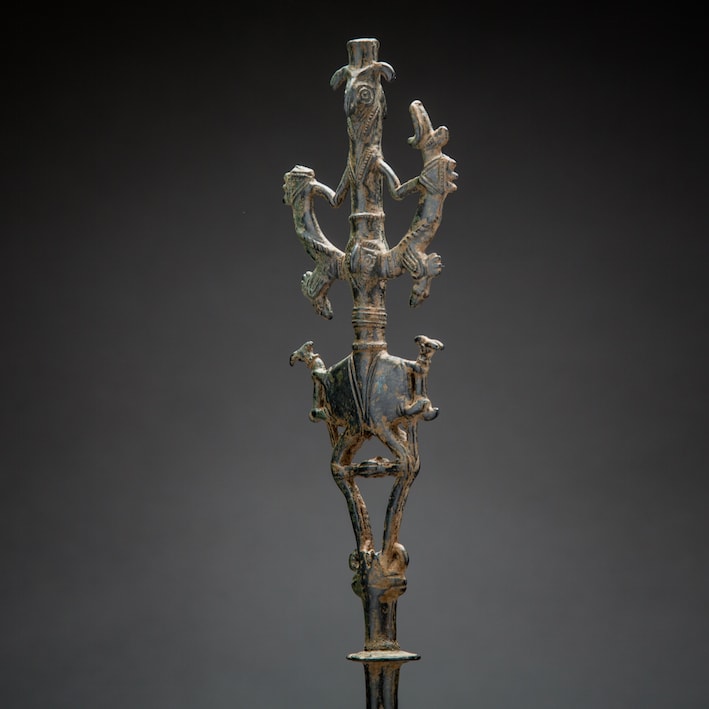Luristan Bronze Standard Finial, 900 BCE - 600 BCE
Bronze
39.6 x 7.6 cm
15 5/8 x 3 in
15 5/8 x 3 in
AM.0181
Further images
This finial was produced in the era when the Luristan metal workshops were at their most prolific, c. 900-600 B.C. Similar designs can be found on a range of items...
This finial was produced in the era when the Luristan metal workshops were at their most prolific, c. 900-600 B.C. Similar designs can be found on a range of items including horse gear, axes and hair and clothing pins. These were all burial items distinguished by the large repertory of animal motifs, both real and imagined. By this period bronze was reserved for decorative artefacts that symbolised social standing among the communities of the Zagros mountains; more mundane, utilitarian objects were made of iron. The hallmark of Luristan wares is the tendency to elongate the necks, tails and bodies of the animals to produce graceful curves and arches. The re-discovery of the splendour of Luristan metalwork began in the 1930s and made considerable progress after World War II. The absence of relevant written records makes their complex imagery difficult to interpret in specific religious terms but it is likely that they represent local deities of some kind. It has been suggested that such elaborate bronze items must have been the preserve of the tribal leaders, a warrior class with the means to equip themselves and their households for war.
This example belongs to a group known as the master/mistress of the beasts. The name derives from the fact that the central human figure is grasping the necks of the two fantastical creatures that form a curve on both sides. Despite the loss of one of the beast heads, this piece is remarkable for the level of detail. A second face appears just above the haunch. Also on this level are two cockerel heads that form a second set of curves. The animal motifs continue on the lower half with two small goats clinging to the sides of the haunch. Below this the figure’s legs, bent at the knees, create the outline of a diamond shape. There are two small hoops above the feet, the purpose of which is unclear. The stem of the finial is unusually fine with several bands of notched decoration and small stylised leaves around the widest section. Although the exact function of these incredible objects is unknown, they still impress us with the sophistication of their design.
For similar examples see G. Markoe ed., Ancient Bronzes, Ceramics and Seals, (Los Angeles, 1981).
This example belongs to a group known as the master/mistress of the beasts. The name derives from the fact that the central human figure is grasping the necks of the two fantastical creatures that form a curve on both sides. Despite the loss of one of the beast heads, this piece is remarkable for the level of detail. A second face appears just above the haunch. Also on this level are two cockerel heads that form a second set of curves. The animal motifs continue on the lower half with two small goats clinging to the sides of the haunch. Below this the figure’s legs, bent at the knees, create the outline of a diamond shape. There are two small hoops above the feet, the purpose of which is unclear. The stem of the finial is unusually fine with several bands of notched decoration and small stylised leaves around the widest section. Although the exact function of these incredible objects is unknown, they still impress us with the sophistication of their design.
For similar examples see G. Markoe ed., Ancient Bronzes, Ceramics and Seals, (Los Angeles, 1981).





